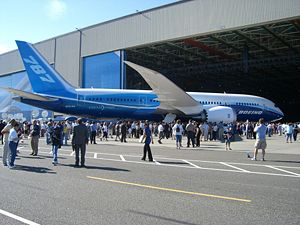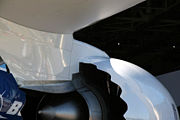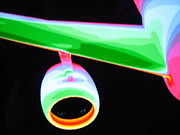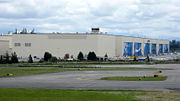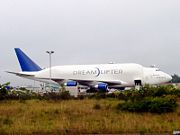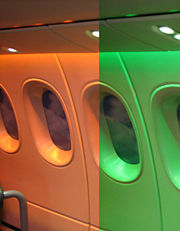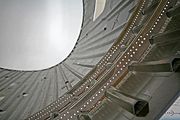Boeing 787
2008/9 Schools Wikipedia Selection. Related subjects: Air & Sea transport
| Boeing 787 Dreamliner | |
|---|---|
|
Boeing 787-8 Dreamliner at roll-out ceremony |
|
| Type | Wide-body jet airliner |
| Manufacturer | Boeing Commercial Airplanes |
| Maiden flight | Targeted for the second quarter of 2008 |
| Status | Production |
| Unit cost | 787-3: US$146–151.5 million 787-8: $157–167 million 787-9: $189–200 million |
The Boeing 787 Dreamliner is a mid-sized, wide-body, twin engine jet airliner currently in production by Boeing Commercial Airplanes. It will carry between 210 and 330 passengers depending on variant and seating configuration. Boeing has stated that it will be more fuel-efficient than earlier Boeing airliners and will also be the first major airliner to use composite materials for most of its construction.
Until January 28, 2005, the 787 was known by the developmental designator 7E7. Early released concept images depicted a radical design with highly curved surfaces. On April 26, 2005, a year after the launch of the program, the final look of the external 787 design was frozen, with a less rakish nose and a more conventional tail.
Boeing featured its first 787 in a rollout ceremony on July 8, 2007 at its assembly factory in Everett, Washington, by which time it had become the fastest-selling wide body airliner in history with nearly 600 orders. Originally scheduled to enter service in May 2008, production has been delayed and it is currently scheduled to enter into service in early 2009.
Development
Background
In the late 1990s, Boeing began considering a replacement for the 767 when sales weakened due to the competing Airbus A330-200. As sales of the Boeing 747-400 were also slowing, the company proposed two new aircraft, which were the Sonic Cruiser and the 747X. The Sonic Cruiser would have achieved higher speeds (approximately Mach 0.98) while burning fuel at the same rate as the existing 767 or A330. The 747X, competing with the Airbus A380, would have lengthened the 747-400 and improved efficiency by using a composite supercritical wing.
Market interest for the 747X was tepid, but the Sonic Cruiser had brighter prospects. Several major airlines in the United States, including Continental, initially showed enthusiasm for the Sonic Cruiser concept, although they also expressed concerns about the operating cost. By decreasing travel time, they would be able to increase customer satisfaction and aircraft utilization.
The September 11, 2001 attacks upended the global airline market. Airlines could not justify large capital expenditures, and increased petroleum prices made them more interested in efficiency than speed. The worst-affected airlines, in the United States, were considered the most likely customers of the Sonic Cruiser. Boeing offered airlines the option of using the airframe for either higher speed or increased efficiency, but the high projected airframe costs caused demand to slacken further. Boeing canceled the 747X once Airbus launched production of the Airbus A380, and switched tracks by offering an alternative product, the 7E7.
Design phase
The replacement for the Sonic Cruiser project was dubbed the 7E7 (with a development code name of Y2.) The "E" was said to stand for various things, depending upon the audience. To some, it stood for "efficiency", to others it stood for "environmentally friendly". In the end, Boeing claimed it merely stood for "Eight", after the aircraft was eventually rechristened "787". A public naming competition was also held, for which out of 500,000 votes cast online the winning title was Dreamliner.
On April 26, 2004, the Japanese airline All Nippon Airways became the launch customer for the 787, then still known as the 7E7, by announcing a firm order for 50 aircraft to be delivered at the end of 2008. ANA's order included 30 787-3, 290–330 seat, one-class domestic aircraft, and 20 787-8, long-haul, 210–250 seat, two-class aircraft for regional international routes such as Tokyo Narita–Beijing. The aircraft will allow ANA to open new routes to mid-sized cities not previously served, such as Denver, Montreal, and Boston. As is common for launch customers, ANA is rumored to have received a discount of 40–50% from list price.
Early concept images of the 787 included rakish cockpit windows, a dropped nose and a distinctive "shark-fin" vertical stabilizer. The final styling of the aircraft was more conservative, the fin appearing visually similar to those of aircraft currently in service. The nose and cockpit windows were also changed to a more conventional form.
The 787-3 and 787-8 will be the initial variants, with the 787-9 entering service in 2010, despite industry rumors that it would be delayed as orders for the 787-3 and 787-8 sold out early production. Boeing initially priced the 787-8 variant at US$120 million, a low figure that surprised the industry. Boeing has since increased the price twice. As of 2007, the list price was $146–151.5 million for the 787-3, $157–167 million for the 787-8 and $189–200 million for the 787-9. Customer-announced orders and commitments for the 787 reached 237 aircraft during the first year of sales, with firm orders numbering 677 by the 787's premiere on July 8, 2007, and well before entry into service. This makes the 787 the fastest-selling wide body airliner ever before entry into service.
The 787 uses the same technology proposed for the Sonic Cruiser in a more conventional configuration (see Features). Boeing claims the 787 will be at least 20% more fuel-efficient than current competing aircraft. One third of the efficiency gain will come from the engines, another third from aerodynamic improvements and the increased use of lighter weight composite materials, and the final third from advanced systems. The most notable contribution to efficiency is the electric architecture which replaces bleed air and hydraulic power with electrically powered compressors and pumps. Technology from the Sonic Cruiser and 787 will be used as part of Boeing's project to replace its entire airliner product line, an endeavor called the Yellowstone Project (of which the 787 is the first stage).
Boeing selected two engine types, the General Electric GEnx and Rolls-Royce Trent 1000, to power the 787, both placed in pods. Significantly, this leaves Pratt & Whitney, which normally has an entrant in the market, unable to offer one of its engines to 787 customers. According to UTC CEO George David, Pratt & Whitney "couldn't make the business case work for that engine." Also, according to industry sources, Boeing may have wished to use evolved versions of existing engines rather than the higher-risk option of an all-new engine from Pratt & Whitney. For the first time in commercial aviation, both engine types will have a standard interface with the aircraft, allowing any 787 to be fitted with either a GE or Rolls-Royce engine at any time. Engine interchangeability makes the 787 a more flexible asset to airlines, allowing them to change easily from one manufacturer's engine to the other's if required. The engine market for the 787 is estimated at US$40 billion over the next 25 years. The launch engine for all three current 787 variants is the Rolls-Royce Trent 1000. Airbus has offered the competing A350 powered by a development of the Rolls Royce Trent turbofan, the Trent XWB.
The launch of a new airliner can be expected to draw scathing comments from competitors, Boeing's doubt over the Airbus A380 and Airbus's mocking of the Sonic Cruiser being recent examples. The 787 is no exception, as Airbus's John Leahy attempted to refute all of Boeing's claims. Leahy openly criticized the large-scale use of composites in the 787's fuselage as being "rushed and ridiculous". Despite this criticism, Boeing built and tested the first composite section while examining the Sonic Cruiser concept nearly five years before, making the 787 a significantly refined product.
The 787 underwent wind tunnel testing at Boeing's Transonic Wind Tunnel, QinetiQ's five-meter wind tunnel at Farnborough, UK, and NASA Ames Research Centre's wind tunnel, as well as at the French aerodynamics research agency, ONERA. Since its inception in 2004, the 787 has had research and development costs ranging from more than $10-12 billion.
Boeing has stated that it is likely to develop a "stretched" version, the 787-10, with seating capacity between 290 and 310. This proposed model is intended to compete with the planned Airbus A350-900. The 787-10 would supersede the 777-200ER in Boeing’s current catalog and could also compete against the Airbus A330-300 and A340-300. Emirates Airlines, Qantas and Vietnam Airlines have shown interest in such a variant that would enter service in 2013. This variant has not yet been officially launched by Boeing, but Mike Bair, head of the 787 Program, has stated that "It's not a matter of if, but when we are going to do it... The 787-10 will be a stretched version of the 787-9 and sacrifice some range to add extra seat and cargo capacity." Although no date has been set, Boeing expects to build a freighter version, possibly in 10 to 15 years.
Production
After stiff competition, Boeing announced on December 16, 2003, that the 787 would be assembled in Everett, Washington. Instead of building the complete aircraft from the ground up in the traditional manner, final assembly employs just 800 to 1,200 people to join completed subassemblies and integrate systems. This is a technique that Boeing has previously used on the 737 program, which involves shipping fuselage barrel sections by rail from Spirit's Wichita, Kansas, facility to Boeing's narrowbody final assembly plant in Renton, Washington. As the major components have many components pre-installed before delivery to Everett, final assembly time is reduced to only three days. This is less than a fourth of the time traditionally needed for Boeing's final assembly process.
In order to speed delivery of the 787's major components, Boeing has modified three 747s purchased from Chinese and Taiwanese airlines. Called Dreamlifters, these widened airplanes can house the wings and fuselage of the 787 as well as other smaller parts.
Boeing manufactures the 787's tail fin at its plant in Frederickson, Washington, the ailerons and flaps at Boeing Australia, and fairings at Boeing Canada Technology. For its entire history, Boeing has guarded its techniques for designing and mass producing commercial jetliner wings. For economic reasons, the wings are manufactured by Japanese companies in Nagoya, e.g. Mitsubishi Heavy Industries; the horizontal stabilizers are manufactured by Alenia Aeronautica in Italy; and the fuselage sections by Vought in Charleston, South Carolina, (USA), Alenia in Italy, Kawasaki Heavy Industries in Japan and Spirit AeroSystems, in Wichita, Kansas, (USA).
The passenger doors are made by Latecoere (France), and the cargo doors, access doors, and crew escape door are made by Saab (Sweden). Japanese industrial participation is very important to the project, with a 35% work share, and many of the subcontractors supported and funded by the Japanese government. On April 26, 2006, Japanese manufacturer Toray Industries and Boeing announced a production agreement involving $6 billion worth of carbon fibre. The deal is an extension of a contract signed in 2004 between the two companies and eases some concerns that Boeing might have difficulty maintaining its production goals for the 787.
From France, Messier-Dowty builds the landing gear and Thales supplies the integrated standby flight display and electrical power conversion system.
Honeywell and Rockwell-Collins provide flight control, guidance, and other avionics systems, including standard dual head up guidance systems. Future integration of forward-looking infrared is being considered by Flight Dynamics allowing improved visibility using thermal sensing as part of the HUD system, allowing pilots to "see" through the clouds.
Connecticut (USA)-based Hamilton Sundstrand provides power distribution and management systems for the aircraft, including manufacture and production of Generator Control Units (GCUs) as well as integration of power transfer systems that can move power from the Auxiliary Power Unit (APU) and the main engines to the necessary parts and machinery of the aircraft. Cold weather test of the APU took place in Alaska.
The first composite fuselage section rolled out in January 2005, and final external design was set in April 2005. On June 30, 2006, Boeing celebrated the start of major assembly of the first 787 at Fuji Heavy Industries' new factory in Handa, Japan, near Nagoya.
On December 6, 2006, Boeing conducted a "virtual rollout" of the 787. Unlike a traditional rollout (which occurred later), it took place without a physical airframe present. Taking computer aided design beyond the aircraft itself, Boeing modeled the manufacturing process, step-by-step and end-to-end, in software. The virtual rollout is intended to discover production issues prior to assembly of the first airframe, when they are cheaper to fix.
On January 12, 2007, first major assemblies, forward fuselage, center wing, and centre wheel well built by FHI and KHI were shipped on 747-400 LCF from Nagoya, Japan. They were delivered to Global Aeronautica in Charleston, South Carolina, on January 15.
On February 15, 2007, the first production nose section ( Section 41) was unveiled at Spirit AeroSystems in Wichita, Kansas. This was the first production nose section, used in the first complete flight-test 787 and represents those used in all subsequent production 787s. It encompasses the cockpit area, nose landing gear well, and the forward-most section of the passenger area. The section is oval-shaped (as is the entire fuselage) and is 21 feet (6.4 m) in height, 19 feet (5.74 m) in width and 42 feet (12.8 m) in length.
On March 14, 2007, the first production vertical tail fin was rolled out at Boeing's Composite Manufacturing Centre in Frederickson, Washington. On April 16, the first production all-composite nose-and-cockpit section was rolled out at Spirit Aerosystem's plant in Wichita, Kansas. The 747-400 LCF Dreamlifter delivered the first horizontal stabilizer manufactured by Alenia Aeronautica at its facility in Grottaglie, Italy to Everett on April 24.
On May 8, 2007, Vought rolled out completed rear Sections 47 and 48 from its factory in Charleston, SC. The sections were flown via the Dreamlifter to Everett, arriving on May 11 along with the all-composite forward section (section 41) manufactured by Spirit AeroSystems.
Mitsubishi Heavy Industries Ltd. shipped the first 787 carbon-fibre wings from its factory in Nagoya to Boeing's main assembly plant in Everett on May 15, 2007.
The Dreamlifter delivered the final major assembly, the integrated midbody fuselage, to Everett on May 16. Final assembly began on May 21 in Everett, Washington. Rolls-Royce shipped the first pair of Trent 1000 engines from their Derby, UK facilities on schedule on June 7 for installation on the Boeing 787. On June 26, 2007 LN1/ZA001 had finished major assembly and was towed to the paint hangar in the early morning.
Boeing started construction of a second 787. This one will be used for static testing and will not be flown. It will not be built with engines or horizontal stabilizers. Also, Boeing has stated reluctance in breaking the composite wing during the test, which would require an expensive cleanup afterwards.
An important milestone in the launch of the 787 was the certification of the Rolls Royce Trent 1000 engine on August 7, 2007, by both European and US regulators. The engine has seven variants and is the first engine to be certified for use on the aircraft.
On August 20, 2007, Hamilton Sundstrand stated that it had delivered its first two cabin air conditioning packs to Boeing for the initial flight-test of the 787 Dreamliner.
First flight & delivery delays
Boeing premiered the first 787 on July 8, 2007, which matches the aircraft's designation in the US-style month-day-year format (7/08/07). However, at the rollout, many of the airplane's parts were attached with non-aerospace fasteners, requiring it to be partly disassembled to replace them with flight fasteners afterwards. It is also understood that the aircraft's major systems and cockpit had not been installed, and no date for the initial 'power up' had been set.
Boeing originally planned for a first flight on August 27, but on August 10, 2007, Boeing spokeswoman Yvonne Leach said that the date might slip, citing factors including final assembly, avionics integration, and completion of software, hydraulic, electronic and other systems. The first flight also depends on the outcome of structural testing on the second plane on the assembly line.
On September 5, 2007, Boeing announced a three-month delay to the first flight, citing a shortage of fasteners and rivets as well as incomplete software. On October 10, 2007 a further three-month delay to the first flight and a six month delay to first deliveries was announced. The Company cited problems with its foreign and domestic supply chain in explaining the delay, especially the ongoing fastener shortage, the lack of documentation from overseas suppliers, and continuing delays in the flight guidance software provided by Honeywell. Less than a week later, the 787 program manager was replaced, although the delivery delays were not cited as a reason for the change.
On January 15, 2008, Boeing announced a further three month delay to the first flight of the 787 due to production issues. As of mid-January 2008, Boeing plans to deliver the first 787 to launch customer All Nippon Airways in early 2009.
After the initial six-month delay to first deliveries, Boeing had still intended to produce 109 of the 112 aircraft it originally planned to produce in 2008 and 2009, then increase production in 2010 to 10 aircraft a month. However, following the announcement of a further three-month delay, the Company has not yet produced a revised delivery schedule. Boeing is known to be talking to its suppliers about the possibility of future increases in production to up to 16 a month.
Design description
Features
The 787 features lighter-weight construction. Its materials (by weight) are: 50% composite, 20% aluminium, 15% titanium, 10% steel, 5% other. Composite materials are significantly lighter and stronger than traditional aircraft materials, making the 787 a very light aircraft for its capabilities. By volume, the 787 will be 80% composite. Each 787 contains approximately 35 tonnes of carbon fibre reinforced plastic, made with 23 tonnes of carbon fibre. Composites are used on fuselage, wings, tail, doors, and interior. Aluminium is used on outer fuselage skin, titanium used mainly on engines with steel used in various places.
The longest-range 787 variant can fly 8,000 to 8,500 nautical miles (14,800 to 15,700 km), enough to cover the Los Angeles to Bangkok or New York City to Taipei routes. It will have a cruise speed of Mach 0.85 (561 mph, 903 km/h at typical cruise altitudes).
The 787 will seat 240 in two-class domestic configuration, with a 46-in (116.8 cm) pitch for first class and a 34-in (86.4 cm) pitch for coach class. 296 passengers can be seated in a high-density 3+2+3 coach arrangement with 36-in (91.4 cm) Business and 32-in (81.3 cm) Coach pitch. Up to 234 passengers may be seated in a three-class setup that uses 61-in (154.9 cm) pitch in First Class (2+2+2 or 2+1+2), 39-in (99 cm) pitch for Business (2+3+2 or 2+2+2) and 32-in (81.3 cm) for Coach (2+4+2). Cabin interior width is approximately 18 feet (547 cm) at armrest, and was increased by 1 inch (2.5 cm) over what was originally planned. The 787's interior cabin width is a full 15 in (38 cm) greater than that of the Airbus A330 and A340, but 5 in (13 cm) narrower than the proposed A350-800 XWB. For economy class in 2+4+2 or 3+2+3 arrangements, seat-bottom widths will be 18.5 in (47 cm), comparable to that found on the Boeing 777. For 3+3+3 seating, the seat widths would be approximately 17.2 in (43.7 cm), the same as those found on the Boeing 737. The vast majority of airlines are expected to select the 3+3+3 configuration on the 787.
The cabin windows are larger than others currently on in-service civil air transport (27 cm by 47 cm), with a higher eye level, so passengers can see the horizon, with Electrochromism-based "auto-dimming" to reduce cabin glare and maintain transparency. These are to be supplied by PPG. Light-emitting diode (LED) cabin lighting (three color) will be used instead of fluorescent tubes, allowing the aircraft to be entirely 'bulbless' and have 128 colour combinations.
A version of Ethernet— Avionics Full-Duplex Switched Ethernet (AFDX) / ARINC 664—will be used to transmit data between the flight deck and aircraft systems. The flight deck features LCD multi-function displays, all of which will use an industry standard GUI widget toolkit (Cockpit Display System Interfaces to User Systems / ARINC 661). The Lockheed Martin Orion spacecraft will use a glass cockpit derived from Rockwell Collins's 787 flight deck. Like other Boeing airliners, the 787 will use a yoke instead of a sidestick.
The internal pressure will be increased to the equivalent of 6000 feet (1800 m) altitude instead of the 8000 feet (2400 m) on conventional aircraft. According to Boeing, in a joint study with Oklahoma State University, this will significantly improve passenger comfort. Higher humidity in the passenger cabin is possible because of the use of composites (which do not corrode). Cabin air is provided by electrically driven compressors using no engine bleed air. An advanced cabin air-conditioning system provides better air quality: Ozone is removed from outside air; HEPA filters remove bacteria, viruses and fungi; and a gaseous filtration system removes odours, irritants and gaseous contaminants.
Bleedless turbofans imply the elimination of superheated air conduits normally used for de-icing, aircraft power, and other functions. These systems are to be replaced by an all-electrical system.
An Active Gust Alleviation system, similar to the system that Boeing built for the B-2 bomber, improves ride quality. Boeing, as part of its "Quiet Technology Demonstrator 2" project, is experimenting with several engine noise-reducing technologies for the 787. Among these are a redesigned air inlet containing sound-absorbing materials and redesigned exhaust duct covers whose rims are tipped in a toothed pattern to allow for quieter mixing of exhaust and outside air. Boeing expects these developments to make the 787 significantly quieter both inside and out.
Boeing engineers designed the 787 interior to better accommodate persons with mobility, sensory, and cognitive disabilities. For example, a 56-inch by 57-inch convertible lavatory includes a movable centre wall that allows two separate lavatories to become one large, wheelchair-accessible facility.
Technical concerns
Engine interchangeability
The two types of engines compatible with the 787 will use a standard electrical interface, potentially allowing any aircraft to be fitted with Rolls-Royce or GE engines at any time. This flexibility will allow an airline to switch from one manufacturer to the other in the event of technological developments that conform more closely to their operating profile. Boeing's goal is to make changing engine types as simple as a standard same-manufacturer replacement.
According to ILFC's Vice President of Marketing, Marty Olson, changing engine types on a 787 could take as long as 15 days and so be economically infeasible. "You'd have to take all the pylon, everything from the wing down, off" Olson said. He went on to complain that Boeing is still promoting the 24 hours change in spite of promises to alter their marketing. Current aircraft can have engines changed to those of a different manufacturer but this rarely happens due to the costs involved. Boeing's response is that the design is not yet finalized and 24 hours remains their goal.
Composite fuselage
The 787's all-composite fuselage makes it the first composite airliner in production. While the Boeing 777 contains 50% aluminium and 12% composites, the numbers for the new airplane are 15% aluminium, 50% composite (mostly carbon fibre reinforced plastic) and 12% titanium. Each fuselage barrel will be manufactured in one piece, and the barrel sections joined end to end to form the fuselage. This will eliminate the need for about 50,000 fasteners used in conventional airplane building. According to the manufacturer the composite is also more durable, allowing a higher cabin pressure during flight compared to aluminium. It was suggested by many that the risks of having a composite fuselage have not been fully assessed and should not be attempted. It was also added that carbon fibre, unlike metal, does not visibly show cracks and fatigue and repairing any damage done to the aircraft would not be easy. Boeing has dismissed such notions, insisting that composites have been used on wings and other passenger aircraft parts for many years and they have not been an issue. They have also stated that special defect detection procedures will be put in place to detect any potential hidden damage.
In 2006, Boeing launched the 787 GoldCare program. This is an optional, comprehensive life-cycle management service whereby aircraft in the program are routinely monitored and repaired as needed. This is the first program of its kind from Boeing: Post-sale protection programs are not new, but have usually been offered by third party service centers. Boeing is also designing and testing composite hardware so inspections are mainly visual. This will reduce the need for ultrasonic and other non-visual inspection methods, saving time and money.
According to Boeing Vice President Jeff Hawk, who heads the effort to certify the 787 for airline service, a crash test involving a vertical drop of a partial fuselage section from about 15 feet onto a one inch-thick steel plate went ahead as planned August 23, 2007 in Mesa, Arizona. Boeing spokeswoman Lori Gunter stated on September 6, 2007 that results matched what Boeing's engineers had predicted. As a result the company can model various crash scenarios using computational analysis rather than performing more tests on actual pieces of the plane. However, it has also been suggested by a fired Boeing engineer that in the event of a crash landing, survivable in a metal plane, the composite fuselage could shatter and burn with toxic fumes.
Weight issues
Boeing had been working to trim excess weight since assembly of the first airframe began in 2006. This is typical for new aircraft during their development phase. The aircraft is first designed on computers and an empty weight is promised to customers to ensure fuel efficiency and payload obligations. However, upon assembly, some parts may be manufactured with minor variances that multiply dramatically if the part is used frequently.
The first six 787s, which are to be used as part of the test program, will be overweight according to Boeing Commercial Airplanes CEO Scott Carson. After the flight test program, these aircraft will be delivered to airline customers All Nippon Airways, Northwest Airlines and Royal Air Maroc at speculated deeper than usual discounts. The first 787 is expected to be 5,000 lb (2,270 kg) overweight. The seventh and subsequent aircraft will be the first optimized 787s and are expected to meet all goals. Boeing has redesigned some parts and made more use of titanium. According to ILFC's Steven Udvar-Hazy, the 787-9's operating empty weight is around 14,000 lb (6,350 kg) overweight, which also could be a problem for the proposed 787-10.
Computer network vulnerability
In January 2008, Federal Aviation Administration expressed concerns about insufficient protection of the Airplane network from possible intentional or unintentional passenger access. The computer network in the passenger compartment, designed to give passengers in-flight internet access, is connected to the plane's control, navigation and communication systems.
Boeing says that although the networks were connected, various hardware and software solutions were employed to protect the plane systems such as:
- Air gaps for the physical separation of the networks,
- Firewalls, for their software separation.
However, they still have to demonstrate to FAA that they have tackled the issue.
Variants
There are three variants of the 787 and all launched at the same time in 2004. The 787-8 will enter service in 2008. The 787-3 will enter service next in 2010. The last to enter service will be the 787-9 in 2010.
787-3
This will be a 223-seat (three-class) or 296-seat (two-class) short-range version targeted at high-density flights, with a range of 2,500 to 3,050 nautical miles (4,650 to 5,650 km) when fully loaded. It is designed to compete with the Airbus A300 and to replace the Boeing 757-300 and Boeing 767-200. The 787-3's intended entry into service is 2010. This model is limited in its range not by fuel capacity but by a low maximum take-off weight of 360,000 lb (163,290 kg). It currently has the same fuel capacity as the 787-8. Actual range is calculated by the remaining available weight capacity for the fuel after the aircraft weight and payload are subtracted from the Maximum Take-Off Weight (MTOW). With a full load of passengers and cargo, it will be limited by the amount of fuel it can take on board. This is an advantage on shorter, high-density routes, especially those separated by water such as Tokyo to Shanghai, Osaka to Seoul, or London to Berlin. Many airports charge landing fees depending on the weight of the aircraft; thus, an airliner rated at a lower MTOW would pay lower fees.
The 787-3's wing will be different from the other versions. It will use large winglets instead of raked wingtips used on other variants. This decreases the wingspan and the aircraft weight. The wing will be the same except for the last 13 feet outboard of the ailerons. Due to the decrease in weight, winglets provide better efficiency over short distances than raked wingtips. The 787-3, having a MTOW considerably lower than the -8 variant, does not need the lift the extra span provides. A lower-than-optimal wing loading decreases efficiency. The twenty-six-feet wingspan reduction also enables the 787-3 to use gates reserved for medium-sized planes.
Thirty years ago it was common to fly from New York to Los Angeles in a 747. Typically, four or five flights occurred per day, one per major airline. With deregulation, more and more airlines joined the route, and existing airlines added flights to provide more variety in departure times. Overcapacity led to airlines using ever-smaller planes. Now there are around 47 direct flights per day, mostly on 737 or Airbus A320 or reconfigured 757s and 767-200s between the two cities, with each flight usually carrying around 100-160 passengers. This has led to higher congestion.
This same phenomenon is occurring in Asia, Europe, and South America. With the proliferation of open sky agreements, numerous airlines have been started in countries like Brazil, India, China, and throughout Europe. These start-ups have placed more pressure on capacity on trunk routes and have encouraged the usage of ever-smaller planes between very large cities. Routes like São Paulo to Buenos Aires, Berlin to Paris, and Mumbai to Calcutta are now increasingly being served by single-aisle planes when larger ones would reduce air traffic congestion.
Boeing believes that the pendulum has swung too far and the future of aviation between very large (but close) cities of five million or more would stabilize around the capacity level of the 787-3. It also believes legacy carriers that want to battle with low-cost airlines can use this plane with twice the capacity of a single-aisle craft but less than twice its operating cost (fuel, landing fees, maintenance, number of flight crew, airspace fees, parking fees, gate fees, etc.). Boeing sees the 787 family as a game-changer, with this variant as the most distinctive of the three.
Regions such as India and East Asia, where large population centers are in close proximity, can make good use of the 787-3. Approximately 3.1 billion people live within the range of the 787-3 if used in India or China. The 787-3's efficiency may offset the higher landing fees and acquisition costs (compared to a single-aisle plane) and make it useful on such routes. A 3,050 nm (5,600 km) range, or flight time of roughly six hours, is sufficient to connect many major cities and improve comfort and efficiency. The 787-3 is not a replacement for single-aisle planes, but it can relegate them to cities with fewer than 2 million people.
To date, however, only Japanese airlines have ordered this model for routes within East Asia.
787-8
The external appearance of the 787-8 is similar to the 787-3 with the exceptions of longer wings with raked wingtips for long-range efficiency and a substantially longer range of 7,650 to 8,200 nautical miles (14,200 to 15,200 km). The 787-8 has a substantially higher maximum take off weight than the 787-3. The 787-8 seats 223 passengers in a three class configuration. The variant will be the first of the 787 line to enter service in 2008. Boeing is targeting the 787-8 to replace the 767-200ER and 767-300ER.
787-9
This will be a "stretched" variant, seating 259 in three classes with a range of 8,000 to 8,500 nautical miles (14,800 to 15,750 km). The targeted entry into service (EIS) is set for 2010. Boeing is targeting the 787-9 to compete with Airbus's A330-200 and A340-200 and to replace their own 767-400ER. This variant is identical to the 787-8 except for structural strengthening, the lengthened fuselage, a higher fuel capacity, and a slightly wider wingspan compared to the 787-8. Each wingtip has been further extended by three feet.
When first launched, the 787-9 had the same fuel capacity as the other two variants. The design differences meant higher weight and resulted in a slightly shorter range than the 787-8. After further consultation with airlines, design changes were incorporated to add a forward tank to increase its fuel capacity. It will now have a longer range and a higher maximum take-off weight (MTOW) than the other two variants. The -9 will be able to fly non-stop from New York to Manila or from Moscow to São Paulo and will have the lowest seat-mile cost of the three 787 variants.
Early sales of this variant were limited by its 2010 entry into service. The 787-8's smaller size and earlier entry date were attractive to most airlines and led to the 787-8 receiving the most orders. With the first four years of production completely sold out, airlines have begun weighing the option of the 787-8 against the 787-9 since either one can be delivered after 2010. Analysts speculate that the 787-9's higher capacity and longer range will eventually make it the most popular variant especially among blue-chip airlines. Air New Zealand is the launch customer for the 787-9 and the second customer ever for the Boeing 787 behind ANA. Qantas, Singapore Airlines, and Continental Airlines have placed the largest orders for the 787-9.
Orders and deliveries
The Boeing 787 has not yet entered service. The first 787 is scheduled to enter passenger service in early 2009, with ANA.
Specifications
| Model | 787-3 | 787-8 | 787-9 |
|---|---|---|---|
| Cockpit crew | Two | ||
| Passengers | 290–330 | 210–250 | 250–290 |
| Length | 186 ft (57 m) | 206 ft (63 m) | |
| Wingspan | 170 ft (52 m) | 197 ft (60 m) | 208 ft (63 m) |
| Wing sweepback | 32.2° | ||
| Height | 55 ft 6 in (16.92 m) | ||
| Fuselage height | 19 ft 5 in (5.91 m) | ||
| Fuselage width | 18 ft 11 in (5.75 m) | ||
| Cabin width | 18 ft (5.49 m) | ||
| Cargo capacity | 4,400 ft³ (124.6 m³) 28 LD3 | 5,400 ft³ (152.9 m³) 36 LD3 | |
| Empty weight | 223,000 lb (101,200 kg) |
242,000 lb (110,000 kg) |
254,000 lb (115,200 kg) |
| Maximum takeoff weight | 364,000 lb (165,100 kg) |
484,000 lb (219,540 kg) |
540,000 lb (244,940 kg) |
| Cruise speed | 0.85 Mach (561 mph, 487 knots, 902 km/h at 40,000 ft) | ||
| Maximum cruise speed | 0.89 Mach (587 mph, 510 knots, 945 km/h at 40,000 ft) | ||
| Range, fully loaded | 2,500 – 3,050 NM (4,650 – 5,650 km) |
7,650 – 8,200 NM (14,200 – 15,200 km) |
8,000 – 8,500 NM (14,800 – 15,750 km) |
| Maximum fuel capacity | 33,528 US gal (126,917 L) | 36,693 US gal (138,898 L) | |
| Service ceiling | 43,000 ft (13,100 m) | ||
| Engines (2×) | General Electric GEnx or Rolls-Royce Trent 1000 | ||
| Maximum thrust capability | 53,000 lbf (236 kN) | 64,000 lbf (285 kN) | 70,000 lbf (311 kN) |
Sources: Airport report, 787-3 fact sheet, 787-8 fact sheet, 787-9 fact sheet
